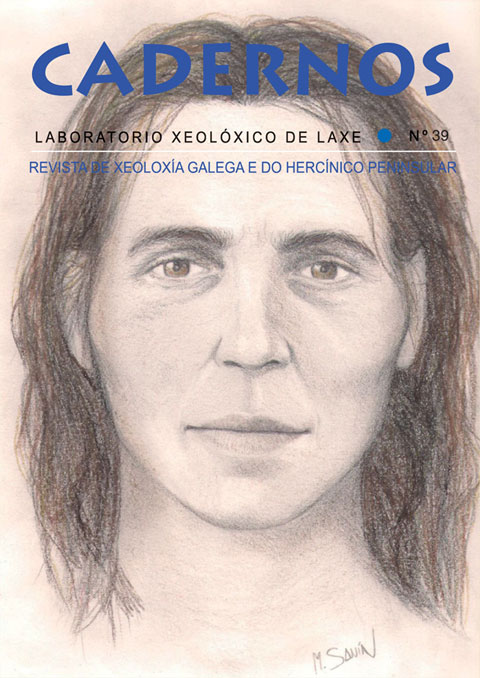The world of a woman named Elba 9300 years ago
Main Article Content
Abstract
Elba, the woman that comes from the mountains is the english translation of the Celtic name that has been chosen for the remains found on an old path that goes from Courel to Ancares (Galice, Spain) and that correspond to a young woman who surprised the death traveling with 3 uros 9300 years ago. It presents the description of the cave where the remains were found, its genetic and isotopic study, a forensic study of its remains as well as a reproduction of its face obtained by the usual restoration techniques.
Keywords:
Downloads
Article Details
References
González Fortes, G., Grandal d'Anglade, A., Vidal Romaní, J.R., Hofreiter, M. (2017). Análisis genético del individuo de Chan do Lindeiro: caracterización de su mitogenoma y situación de la muestra en el contexto paleogenético europeo. Cadernos do Laboratorio Xeolóxico de Laxe, presente volumen.
Grandal-d'Anglade, A., Vidal Gorosquieta, A. (2017). Caracterización isotópica de Elba, la mujer mesolítica de Chan do Lindeiro (Pedrafita, Lugo, Península Ibérica). Cadernos do Laboratorio Xeolóxico de Laxe, presente volumen.
Railsback, L. B., Liang, F., Vidal Romaní, J.R., Grandal-d'Anglade, A., Vaqueiro Rodríguez, M., Santos Fidalgo, L., Fernández Mosquera, D., Cheng, H., Lawrence Edwards, R. (2011). Petrographic and isotopic evidence for Holocene long-term climate change and shorter-term environmental shifts from a stalagmite from the Serra do Courel of northwestern Spain, and implications for climatic history across Europe and the Mediterranean. Palaeogeography, Palaeoclimatology, Palaeoecology t. 315,172-184.
Sanín Matías, M. y Serrulla, F. (2017). Informe antropológico forense: aproximación facial. Cadernos do Laboratorio Xeolóxico de Laxe. 39, pp. 71-86.
Sanjurjo Sánchez, J.; Vidal Romaní, J. R.; Vaqueiro Rodríguez, M.; Costas Vázquez, R.; Grandal D'Anglade, A. (2013). TL estimation of ages of pottery fragments recovered from granite caves in the NW coast of Spain. Cadernos do Laboratorio Xeolóxico de Laxe, 37, 73- 88.
Santos, L.; Vidal Romaní, J. R. & Jalut, G. (2000). History of vegetation during the Holocene in the Courel and Queixa Sierras, Galicia, northwest Iberian Península. Journal of Quaternary Science, 15(6), 621-632.
Steelman, K.L.; de Lombera-Hermida, A.; Viñas-Villaverdú, R.; Rodríguez-Álvarez, X.P.; Carrera-Ramírez, F.; Rubio-Mora, A. & Fábregas-Valcárcel, R. (2017). Cova Eirós: an integrated approach to dating the earliest known cave art in NW Iberia. Radiocarbon, vol. 59. Nr 1, pp. 151-164. DOI: https://doi.org/10.1017/RDC.2017.4
Serrulla, F., Sanín Matías, M. (2017). Forensic antropological report of Elba. Cadernos do Laboratorio Xeolóxico de Laxe. 39, pp. 33-70.
Vaqueiro-Rodríguez, M.; Costas Vázquez, R.; Costas-Suárez D., Vidal-Romaní, J.R. (2017). Características morfológicas de la Sima del Uro (NO, España). Morphologic map of "Sima del Uro" (NW, Spain). Cadernos do Laboratorio Xeolóxico de Laxe. 39, pp. 23-34.
Vaqueiro, M. (2017). Cavidades naturales en rocas magmáticas. Las cuevas en rocas plutónicas. Tesis doctoral. Universidad de Coruña. 492 pp. (inédita)
Vidal Gorosquieta, Amalia; Grandal-D'Anglade, Aurora; Vaqueiro-Rodríguez, M. & Vidal-Romaní, J.R. (2016). Galician aurochs: a morphologic, metric and isotopic study. 1st IMERP.XIV EJIP. New perspectives on the Evolution of Phanerozoic Biotas and ecosystems. pp.167.
Vidal Romaní, J.R. (2015). La Geología de Galicia o como armar un rompecabezas. Discurso de Ingreso en la Real Academia Gallega de Ciencias. Santiago de Compostela.
Vidal Romaní, J.R.; Vaqueiro, M. (2007). Types of granite cavities and associated speleothems: genesis and evolution. Nature Conservation 63, 41-46.







